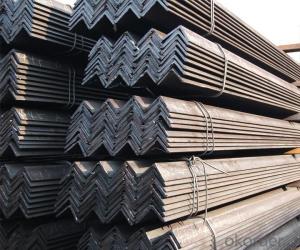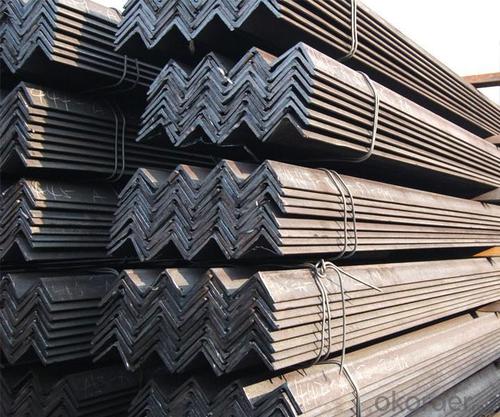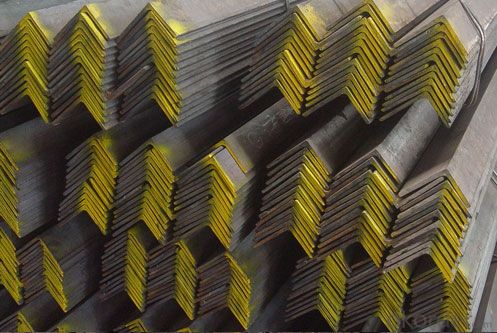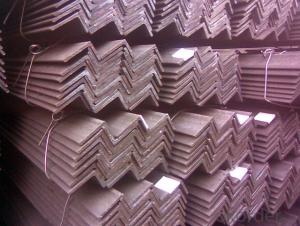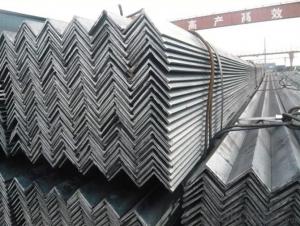Unequal Steel Angle S235jrg Hot Dip Galvanized
- Loading Port:
- Tianjin
- Payment Terms:
- TT or LC
- Min Order Qty:
- 30 m.t.
- Supply Capability:
- 35000 m.t./month
OKorder Service Pledge
OKorder Financial Service
You Might Also Like
Product Description:
OKorder is offering Unequal Steel Angle S235jrg Hot Dip Galvanized at great prices with worldwide shipping. Our supplier is a world-class manufacturer of steel, with our products utilized the world over. OKorder annually supplies products to European, North American and Asian markets. We provide quotations within 24 hours of receiving an inquiry and guarantee competitive prices.
Product Applications:
Unequal Steel Angle S235jrg Hot Dip Galvanized are ideal for structural applications and are widely used in the construction of buildings and bridges, and the manufacturing, petrochemical, and transportation industries.
Product Advantages:
OKorder's Unequal Steel Angle S235jrg Hot Dip Galvanized are durable, strong, and resist corrosion.
Main Product Features:
· Premium quality
· Prompt delivery & seaworthy packing (30 days after receiving deposit)
· Corrosion resistance
· Can be recycled and reused
· Mill test certification
· Professional Service
· Competitive pricing
Product Specifications:
Specification:GB/EN/ASTM/JIS/ S275JR
Grade:A36,SS400,Q235,Q345,ST37,ST52
Zinc thickness:30-100um(200-600g/m2)
Size: from Size 25--Size 100
FAQ:
Q1: Why buy Materials & Equipment from OKorder.com?
A1: All products offered byOKorder.com are carefully selected from China's most reliable manufacturing enterprises. Through its ISO certifications, OKorder.com adheres to the highest standards and a commitment to supply chain safety and customer satisfaction.
Q2: How do we guarantee the quality of our products?
A2: We have established an advanced quality management system which conducts strict quality tests at every step, from raw materials to the final product. At the same time, we provide extensive follow-up service assurances as required.
Q3: How soon can we receive the product after purchase?
A3: Within three days of placing an order, we will begin production. The specific shipping date is dependent upon international and government factors, but is typically 7 to 10 workdays.
Images:
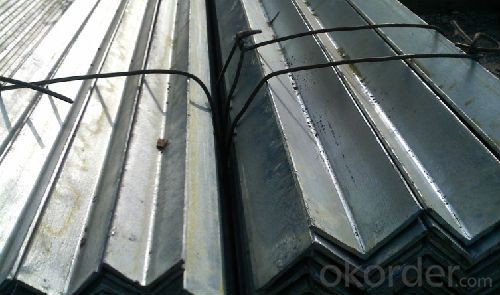
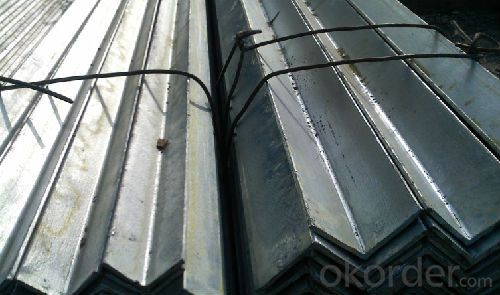
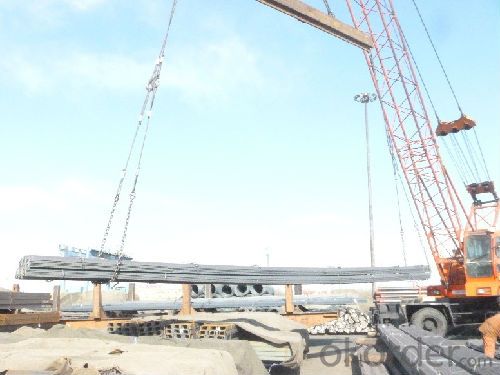
- Q: Can steel angles be used for supports in bridges?
- Steel angles can indeed be utilized as supports in bridges. These angles are frequently employed in bridge construction due to their capacity to provide both strength and stability. They serve as vertical supports, known as piers or columns, as well as horizontal supports, referred to as beams or girders. The usage of steel angles in bridge construction offers numerous benefits. These include their exceptional strength-to-weight ratio and their ability to endure substantial loads and vibrations. Moreover, steel angles are highly adaptable and can be easily fabricated and connected, resulting in efficient and cost-effective bridge construction. All in all, due to their enduring nature, dependability, and efficiency in supporting the weight and load of a bridge structure, steel angles are widely favored as a choice for bridge supports.
- Q: How are steel angles protected against impact damage?
- Steel angles can be protected against impact damage through various methods. One common approach is to use impact-resistant coatings or paints that are specifically designed to absorb and distribute the force of an impact, thereby minimizing the damage caused. These coatings can be applied to the surface of the steel angles, providing an additional layer of protection. Another method is to use rubber or plastic bumper guards, which can be attached to the edges or corners of the steel angles. These guards act as a buffer, absorbing the impact energy and preventing direct contact between the steel angle and the object causing the impact. This helps to reduce the risk of denting or deformation. In some cases, steel angles may be reinforced with additional structural elements, such as bracing or stiffeners, to enhance their resistance to impact damage. These reinforcements can help distribute the force of an impact more evenly across the structure, reducing the risk of localized damage. Furthermore, proper installation and maintenance practices play a crucial role in protecting steel angles against impact damage. Ensuring that the angles are securely fastened and regularly inspected for any signs of wear or damage can help identify potential issues before they escalate. Overall, a combination of impact-resistant coatings, bumper guards, structural reinforcements, and diligent maintenance can effectively protect steel angles against impact damage, prolonging their lifespan and ensuring their structural integrity.
- Q: How to determine the neutral axis of the angle bar?
- The neutral axis is a line which is the intersection of the neutral plane and the neutral axis corresponding to the strong axis of the cross section. The neutral axis is equal to the bisector of the sectional area parallel to the curved main axis, and the area on both sides of the neutral axis is equal, and the biaxial symmetry section is the centroid axis.
- Q: How do you calculate the shear force on a loaded steel angle?
- To calculate the shear force on a loaded steel angle, you need to consider the applied load, the geometry of the angle, and the material properties of the steel. The shear force refers to the force acting parallel to the cross-sectional area of the angle. First, determine the applied load that is acting on the steel angle. This could be a concentrated load, distributed load, or a combination of both. It is important to accurately determine the magnitude and location of the load. Next, consider the geometry of the steel angle. The angle has two legs, with each leg having a specific length, width, and thickness. Measure these dimensions accurately. Once you have the load and angle dimensions, you can calculate the shear force using the formula: Shear Force = Load / Cross-sectional Area To calculate the cross-sectional area, you need to consider the shape of the angle. The cross-sectional area of a steel angle is typically calculated as the sum of the areas of the two legs minus the area of the corner radius. If the angle has unequal legs, the cross-sectional area can be calculated as the sum of the areas of the longer and shorter legs minus the area of the corner radius. After calculating the cross-sectional area, divide the applied load by this value to obtain the shear force on the loaded steel angle. It is important to note that the above calculation assumes the steel angle is subjected to pure shear. In practical situations, other factors such as bending moments and torsion may also need to be considered, which would require more complex calculations and analysis. Therefore, it is advisable to consult relevant design codes, structural engineering principles, or seek the advice of a professional engineer for accurate and reliable results.
- Q: What are the different types of steel angles connections for trusses?
- There are several types of steel angle connections commonly used for trusses, including gusset plate connections, bolted connections, welded connections, and clip angles.
- Q: How do steel angles perform in cold weather conditions?
- Steel angles perform well in cold weather conditions due to their high strength and durability. The cold temperature does not significantly affect the performance and structural integrity of steel angles, making them suitable for various applications in cold climates.
- Q: How do you calculate the section modulus of a steel angle?
- The section modulus of a steel angle can be calculated by dividing the moment of inertia of the angle cross-section by the distance of the furthest point from the centroid to the extreme fiber.
- Q: Can steel angles be used for agricultural buildings or barns?
- Yes, steel angles can be used for agricultural buildings or barns. Steel angles are commonly used in construction due to their strength and durability. They are particularly useful in agricultural buildings or barns where the structure needs to withstand heavy loads and harsh weather conditions. Steel angles can be used for framing, bracing, and reinforcing various components of the building, such as walls, roofs, and doors. Additionally, steel angles can be easily fabricated and customized to meet specific design requirements, making them a versatile choice for agricultural buildings or barns.
- Q: What are the different standards for steel angles?
- The different standards for steel angles include the American Society for Testing and Materials (ASTM) A36 standard, which is commonly used in the United States, and the European standard EN 10025, which is widely used in Europe. These standards outline the specific requirements for the chemical composition, mechanical properties, and dimensions of steel angles, ensuring consistency and quality in their production and use.
- Q: How are steel angles installed on concrete structures?
- Steel angles are typically installed on concrete structures using anchor bolts. These anchor bolts are drilled into the concrete and then the steel angles are placed over these bolts. Nuts and washers are then tightened onto the anchor bolts to secure the steel angles in place.
Send your message to us
Unequal Steel Angle S235jrg Hot Dip Galvanized
- Loading Port:
- Tianjin
- Payment Terms:
- TT or LC
- Min Order Qty:
- 30 m.t.
- Supply Capability:
- 35000 m.t./month
OKorder Service Pledge
OKorder Financial Service
Similar products
Hot products
Hot Searches
Related keywords
